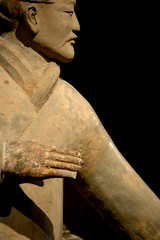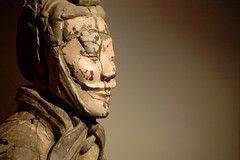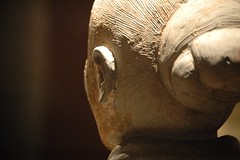
I left for D.C. on Wednesday knowing very little about the Terra Cotta Warriors that I was going to see on display at the National Geographic Museum, and I returned home knowing just a little bit more than that.
The only difference between then and now is that now I have pictures, and having pictures means that I have a responsibility to say something that matters about these guys.
So I went digging and this is what I found -- sources vary and are cited below. I offer them to you now along with an apology if any of this is old news:
- Long before the Warriors were “discovered” in Lin Tong in 1974, locals told stories of unfortunate ancestors “who dug too deeply in the earth and saw the face of a ghost, half-hidden in dirt,” and were plagued with bad fortune for their trouble. [1]
- The farmers who were sinking the well that brought the warriors to light were at first ignored by local officials. The bureaucrat who was called in to examine the torso hauled in to county headquarters by Farmer Yang (which was no mean feat -- each Warrior weighs between 300 and 400 pounds) left it languishing in a back storeroom for some time before he declared that it was maybe 100 years old and not all that interesting. By chance an archaeologist from Xi’an heard about the discovery and recognized its significance.
- The tomb was sacked and burned by enemies of the state before it was completed. The Warriors were buried in the warehouse where they were awaiting placement. It's believed that this is the reason several rooms of the tomb were found empty.
- An elaborate river scene within the "entertainment center" of the Necropolis was, however, completed before the attack. According to the exhibit placard: "The longest hall takes the form of a river with a bank on each side, paralleling a river system above ground. Bronze birds, including cranes, swans, and geese were placed along the underground river's length. The 46 birds in the flock are all in naturalistic poses, each one slightly different."
- The Emperor of China, Qin Shi Huang or Shihuangdi, on whose behalf the 8,000+ warriors were interred, was the first emperor China ever had.
- According to Chinese officials, his burial chamber has yet to be excavated.
- Under his rule the entire country took on the name of his home state Qin (because all of China had in fact been swallowed by Qin -- pronounced “chin”), and it’s thought that the western name “China” is probably derived from this place name.
- Historians were largely unkind to Emperor Qin and described him as a hard ass who distrusted scholars and burned books. Some suggest that this description was politically motivated and not entirely true.
- Under the first Emperor’s rule weights, measures, language and currencies were standardized -- and coin standards included some crazy shapes like spades and blades, in addition to the traditional circular form which ultimately won out.
- Emperor Qin started construction on the Great Wall of China. Most of the “pounded earth and stone” that comprised his Wall was later replaced by brick in the Ming Dynasty, but some fragments of the original structure still remain.
- His terra cotta soldiers were not, in fact, individualized portraits, but: "an early feat of mass production: a small and quite limited repertoire of body parts were joined together in a multitude of combinations, with details worked by hand afterwards. Then the whole figures were painted. Endless variety of costumes, hairstyles, hand positions or facial features was therefore possible, but in no way were they individual portraits. The clay warriors were stamped with the name and unit of the foreman of a group of workmen, as part of an elaborate system of quality control." [2]



Jane Portal also reports in The first emperor: China's Terracotta Army that:
The First Emperor wanted to live for ever and go on ruling eternally. Following several assassination attempts on his life, he tried to achieve physical immortality with the help of alchemists who prescribed pills and potions featuring large amounts of mercury. He also sent groups of envoys to the mythical isles of the immortals off the east coast to seek elixirs of immortality.

Given that, I shouldn’t have been so easily awed by the findings of researchers at Stanford who recently ran a chemical analysis of the Chinese Purple pigment used on the Terra Cotta Warriors -- a rare, synthetically derived pigment that some have speculated was received in a trade with the Egyptians long before the Silk Road became established. Please bear with the lengthy excerpt -- this is fascinating:
In order to address these questions [of provenance], we re-examined the chemistry and the morphology of purple pigments found on one of the Qin Terracotta warriors. By combining our findings of the technology used in the synthesis of Chinese Purple with existing archaeological evidence, we conclude that Taoist alchemists invented this pigment as well as the related pigment Chinese Blue independently from any Egyptian influence.
These chemical maps and maps of the crystallographic orientation suggest that Chinese Purple was synthesized using lead flux melting, a process very similar to that for glass making. Diffusion of heavy elements such as Ba, and even Cu, is very sluggish even at 1000 C and limits the grain sizes in a solid state synthesize to a few microns, as is frequently seen for solid state synthesis of high Tc superconductors which have similar heavy ion composition. However, if the pigment crystallites grew from a melt, as Pb elemental map and the grain growth morphology suggest, then the grain growth kinetics are not governed by diffusivity of individual ions, but by the flow due to thermal convention, which is significantly higher than solid state diffusion. Therefore, the presence of large pigment crystallites (20μm-50μm), in conjunction with the growth morphology suggest that pigment crystals grew in presence of liquid and probably even precipitated from a melt.(...)
Historical records suggest that Taoist alchemists are responsible for the making of these barium-lead-containing glasses. It is known that jade holds a special status in Taoism.
Taoist believed that jade, which they considered to be a magical material, not only held the power to preserve a human body and spirit (Needham and Lu 1974) but also was an elixir for achieving physical immortality (Ko 320). In the pursuit to understand and obtain such a precious material, the Taoist monks started to synthesize it themselves. Several records in ancient Chinese texts mentioned Taoist monks making jade (glass) by fusing stones. As recorded in “Lun Heng” (Wang 27-97), “the Taoist monks used to make five-colored jade with five stones....” More importantly, it also mentioned that glass could achieve a certain appearance when different raw materials were added during the process, “Suihou (the duke of Sui) made beads out of several ‘medicines’ which were more shiny and appealing.”
As we know today, the barium glass has a larger refractive index than that of a normal glass. This would give barium glass a certain turbidity and a jade-like appearance. Glass (Jade) makers would have found this by trial and error. Barium minerals, such as Barite (BaSO4) or Witherite (BaCO3), are reasonably common in central China. This mineral is unusually heavy and forms “appealing” crystals, so the Chinese, as careful observers and curious chemists, would no doubt have found and experimented with it. In this process of imitating jade, they discovered the recipe of the barium containing glass. Then, the copper minerals, Malachite (Cu2(CO3)(OH)2) or Azurite (Cu3(CO3)2(OH)2), could be added later to obtain different jade colours. We believe that this experimentation led to the eventual discovery of Chinese Purple. [3]
The researchers report that the Chinese Purple wasn’t used much before this occasion, and was seldom seen afterward, which they suggest is an indication of the declining tide of Taoism.
Before then, however, as Jennifer Oldstone-Moore reports in her book on Taoism: origins, beliefs, practices, holy texts, sacred places, Taoist "individuals knowledgeable in techniques for achieving immortality -- the fang-shih, or ‘gentlemen with recipes’ -- were hired by imperial courts to reveal their secrets.” [4]
And so it would seem that Qin contracted with Taoist fang-shih to act as celestial tailors -- clothing his warriors in immortality to ensure his rule for all eternity.
Terra Cotta Warriors: Guardians of China's First Emperor
National Geographic Museum
1145 17th Street NW, Washington DC
Exhibition open daily from 10AM to 6PM
Hours extended to 9PM on Wednesdays, and the first 200 to line up by 5.30 will receive free entrance at 6PM.

[1] Seth Faison, South of the Clouds: Exploring the Hidden Realms of China. St. Martin's Press, October 2004.
[2] Jane Portal and Hiromi Kinoshita, The first emperor: China's Terracotta Army. Harvard University Press, 2007.
[3] Influence of Taoism on the Invention of the Purple Pigment Used on the Qin Terracotta Warriors, Z. Liu1,3, A. Mehta1, N. Tamura2, D. Pickard3, B. Rong4, T. Zhou4 and P. Pianetta. Stanford Synchrotron Radiation Lab, Stanford University, Stanford, California 94305
USA
[4] Jennifer Oldstone-Moore, Taoism: origins, beliefs, practices, holy texts, sacred places. Oxford University Press, 2003.
p.s. The invitation to attend the bloggers’ preview of the exhibit was my excuse to have a lovely play day in the middle of the week in Washington D.C., and the excuse came my way only because my Twitter buddy @bobcatrock spotted the open call for bloggers on Flickr and passed the link my way.
Thank you thank you thank you, Mr. Bobcat. As excuses go, it was one of the best.








1 comment:
Wow, thanks for sharing! I'd always heard that about them being individual portraits; it's fun to have what you "know" already turn out to be completely wrong.
Post a Comment